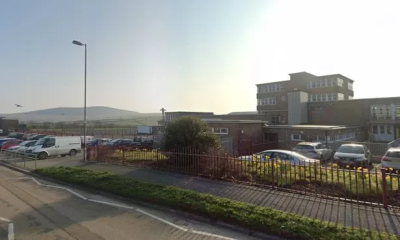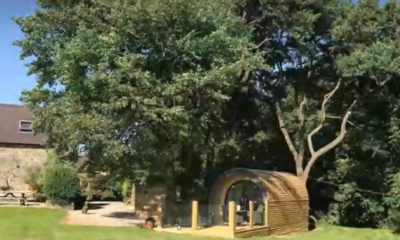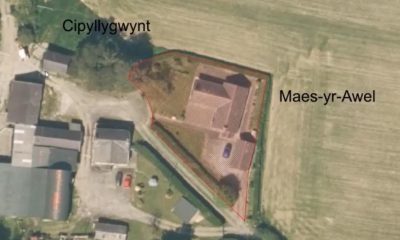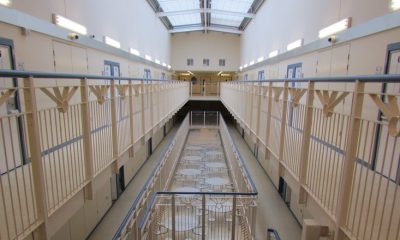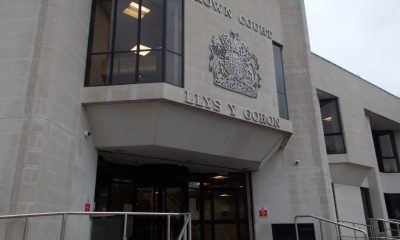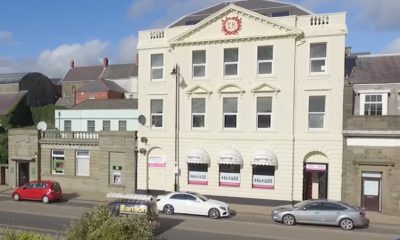News
Pembroke Castle excavation completed

THE TWO WEEK archaeological excavation of Pembroke Castle has finished, with much information and material gathered to be analysed.
Dyfed Archaeological Trust, funded by the Castle Studies Trust, started the excavation on September 3, the first at the site for over 70 years. The excavations and topographic survey aimed to further advance the understanding of one of Wales’ and the UK’s most iconic castles.
The large outer ward has been an empty space since at least the eighteenth century, yet aerial photographs in 2013 revealed parch marks detailing the outline of a possible late medieval double-winged hall house. This was further confirmed by geophysical surveys carried out by Dyfed Archaeological Trust, funded by the Castle Studies Trust, in 2016. Such buildings are unusual in castles, particularly in the outer ward, generally associated with more lowly structures. This may suggest that the ward had been ‘gentrified’ matching historical accounts which place the birth of Henry Tudor in the outer ward: it may have occurred within this very building. It is thought more likely that he was born in what was a modern residence for the time, than in a guard tower on the castle walls.
Under the guidance of well-known castle expert Neil Ludlow, Dyfed Archaeological Trust excavated two trenches to understand more about the form, date, context and function of the remains. Additionally, they carried out a topographic survey to make a detailed record of the layout of the castle.
Neil Ludlow said prior to the excavation: “The geophysical survey carried out in Pembroke Castle, in 2016, funded by the Castle Studies Trust, showed a large, winged building that resembles, in plan, a late-medieval manor house. This is an unusual find within a castle, and has additional significance at Pembroke as the possible birthplace of King Henry VII.
“But this is still guesswork, as nothing else about the building is known. All we really know is that it was excavated in the 1930s without records. Thanks to the support of the Castle Studies Trust, some of these questions will be answered as well as learning more about later medieval high status living.”
Pembroke Castle stands on a site that has been occupied since at least the Roman period. Norman lords founded the first traditional castle there in the 11th century. Henry Tudor was born at Pembroke Castle on January 28 1457. On August 22 1485, Henry seized the English crown, defeating King Richard III at the Battle of Bosworth Field, in the culmination of the Wars of the Roses. He was the last king of England to win his throne on the field of battle, and was crowned Henry VII, first monarch of the House of Tudor.
On the first day of the excavation, a possible wall was quickly made visible in trench one, and trench two revealed a former path surface through the castle grounds and the suggestion of an outer wall. Bone, pottery, brick and tile were found, most from the early 20th century but with some late medieval and post medieval material as well.
The second day saw a second wall revealed close to the east, yet the walls appeared too close together to be associated with the walls seen on the parch marks. Large areas of mortared stone patches were revealed to the west, suggesting walls, and the outer wall of the building in trench two started to become exposed as well. A large amount of oyster shell was collected from the site as well as more pottery and bone.
On the third day, the full width of the wall in trench two was made visible at its western end, at roughly one metre wide, suggesting a substantial structure. In trench one the two walls located close together were thought to represent the cess pit.
The fourth day brought wind and rain, but did not deter progress, with more backfill being removed from both trenches to reveal the surviving walls of the structure. Day five saw good progress, removing almost all of the remaining backfill from trench one to reveal a rubble collapse layer – pre-dating the 1930s excavations. The large mass of masonry is thought to be a possible curving stair, whilst the top of the large wall in trench two was fully exposed.
The sixth day saw further poor weather, and so the focus was on washing and sorting the cleaned finds for bagging up. By the afternoon the weather improved somewhat and the team were able to start the removal of layers of building collapse within the trenches.
Members of the Castle Studies Trust who are funding the investigation visited the site on day seven to check on progress. Work continued in trench one revealing an area of potential bedrock within the possible small room at its eastern end. Collapse material has been removed from trench two to reveal a spread of mortar and slate, potentially a collapsed roof within the structure.
The eighth day saw a sample excavation of the small room in trench one completed, exposing more of a large outcrop of limestone bedrock in its base. Cadw gave permission to slightly extend the trenches and this was started in the afternoon.
The ninth day saw trench two extended to expose the return of the large wall in the northwestern corner of the building, which again appears to be a substantial wall, suggesting a tall building. The extension in trench one was also continued, but no continuation of any walls were seen, although a deposit of rubbish was revealed containing large quantities of roofing slate, oyster shell, bone and quite a few pieces of glazed tile.
The tenth day saw the return of the wall in the second trench fully exposed, the cobbled surface on the outside of the wall cleaned and a rough stone slab floor adjacent to the steps was exposed. They finished taking the eastern extension of the trench down to the correct level, and commenced excavation of the possible cess pit, which is being sampled for environmental analysis.
Day 11 saw the recording and site survey start, as they finished excavation of a small test pit in trench one, onto a second possible stone slab floor. The east end of the trench was found to contain a mix of material, with pottery dating throughout the medieval and later medieval period, as well as three shards of Roman pottery too.
Day 12 was spent undertaking further recording and drawing in the two trenches as the work drew to a close.
The recording was finished on the thirteenth day, as they started backfilling in the afternoon.
In between the volunteers stopped to watch the 1st Battalion Royal Welsh being given the freedom of Pembroke. The last day saw both trenches were backfilled and re-turfed by the end.
Education
Pembrokeshire school named second in Sunday Times guide

A Pembrokeshire secondary school has been recognised among the very best in Wales, securing a leading position in a major national education guide.
Ysgol Bro Preseli in Crymych has been ranked the second-best state secondary school in Wales in the 2026 Sunday Times Parent Power Guide, a long-established benchmark for academic performance across the UK. Only Cowbridge School placed higher.
The annual guide, regarded as one of the country’s most authoritative assessments of school standards, compiles data from more than 2,000 state and independent schools. It also offers a range of practical advice for families, including guidance on scholarships, the 11-plus, and choosing the right school.
Helen Davies, editor of the Parent Power Guide, acknowledged the pressures facing the education sector but praised the commitment shown by schools nationwide. She said: “The educational landscape is testing – budget challenges, rising student mental health issues, special educational needs and an increasingly uncertain future.
“But there is also so much to celebrate from the dedication of teachers who are finding ever more innovative and impactful ways to enrich their students and give them the very best start in life.
“As well as celebrating the academic excellence of the top schools, it is uplifting to see how they are shaping their students to be ready for the 21st century, and instilling a lifelong love of learning.”
In addition to its strong showing within Wales, Ysgol Bro Preseli secured 263rd place in the UK-wide rankings. Elsewhere in the state secondary table, Ysgol Gyfun Penweddig was placed third in Wales, with Ysgol Eirias in Colwyn Bay following closely behind.
Now in its 33rd year, the Parent Power Guide was published online on Friday, 5 December, with the print edition set to appear on Sunday, 7 December. Final positions are determined by year-on-year performance, supported by editorial judgement.
The full rankings and analysis are available via The Sunday Times digital edition, and the guide remains a trusted resource for families seeking a clear picture of school performance across the UK.
Crime
Swansea man dies weeks after release from troubled HMP Parc: Investigation launched
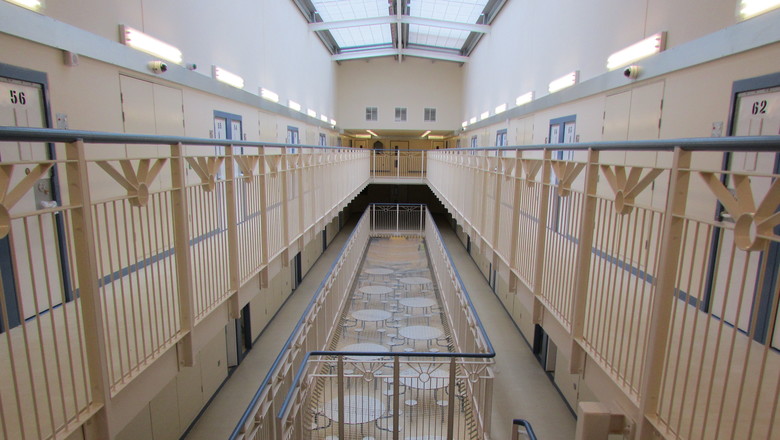
A SWANSEA man has died just weeks after being released from HMP Parc, the Bridgend prison now at the centre of a national crisis over inmate deaths and post-release failures.
Darren Thomas, aged 52, died on 13 November 2025 — less than a month after leaving custody. The Prisons and Probation Ombudsman (PPO) has confirmed an independent investigation into his death, which is currently listed as “in progress”.
Born on 9 April 1973, Mr Thomas had been under post-release supervision following a period at HMP/YOI Parc, the G4S-run prison that recorded seventeen deaths in custody in 2024 — the highest in the UK.
His last known legal appearance was at Swansea Crown Court in October 2024, where he stood trial accused of making a threatening phone call and two counts of criminal damage. During the hearing, reported by The Pembrokeshire Herald at the time, the court heard he made threats during a heated call on 5 October 2023.
Mr Thomas denied the allegations but was found guilty on all counts. He was sentenced to a custodial term, which led to his imprisonment at HMP Parc.
Parc: A prison in breakdown
HMP Parc has faced sustained criticism throughout 2024 and 2025. A damning unannounced inspection in January found:
- Severe self-harm incidents up 190%
- Violence against staff up 109%
- Synthetic drugs “easily accessible” across wings
- Overcrowding at 108% capacity
In the first three months of 2024 alone, ten men died at Parc — part of a wider cluster of twenty PPO-investigated deaths since 2022. Six occurred within three weeks, all linked to synthetic drug use.
Leaked staff messages in 2025 exposed a culture of indifference, including one officer writing: “Let’s push him to go tomorrow so we can drop him.”
Six G4S employees have been arrested since 2023 in connection with alleged assaults and misconduct.
The danger after release
Deaths shortly after release from custody are a growing national concern. Ministry of Justice data shows 620 people died while under community supervision in 2024–2025, with 62 deaths occurring within 14 days of release.
Short sentences — common at Parc — leave little time for effective rehabilitation or release planning. Homelessness, loss of drug tolerance and untreated mental-health conditions create a high-risk environment for those newly released.
The PPO investigates all such deaths to determine whether prisons or probation failed in their duties. Reports often take 6–12 months and can lead to recommendations.
A system at breaking point
The crisis at Parc reflects wider failures across UK prisons and probation. A July 2025 House of Lords report described the service as “not fit for purpose”. More than 500 people die in custody annually, with campaigners warning that private prisons such as Parc prioritise cost-cutting over care.
The PPO investigation into the death of Darren Thomas continues.
Crime
Woman stabbed partner in Haverfordwest before handing herself in

A WOMAN who stabbed her partner during a drug-fuelled episode walked straight into Haverfordwest Police Station and told officers what she had done, Swansea Crown Court has heard.
Amy Woolston, 22, of Dartmouth Street in Milford Haven, arrived at the station at around 8:00pm on June 13 and said: “I stabbed my ex-partner earlier… he’s alright and he let me walk off,” prosecutor Tom Scapens told the court.
The pair had taken acid together earlier in the day, and Woolston claimed she believed she could feel “stab marks in her back” before the incident.
Police find victim with four wounds
Officers went to the victim’s home to check on him. He was not there at first, but returned shortly afterwards. He appeared sober and told police: “Just a couple of things,” before pointing to injuries on his back.
He had three stab or puncture wounds to his back and another to his bicep.
The victim said that when he arrived home from the shop, Woolston was acting “a bit shifty”. After asking if she was alright, she grabbed something from the windowsill — described as either a knife or a shard of glass — and stabbed him.
He told officers he had “had worse from her before”, did not support a prosecution, and refused to go to hospital.
Defendant has long history of violence
Woolston pleaded guilty to unlawful wounding. The court heard she had amassed 20 previous convictions from 10 court appearances, including assaults, battery, and offences against emergency workers.
Defending, Dyfed Thomas said Woolston had longstanding mental health problems and had been off medication prescribed for paranoid schizophrenia at the time.
“She’s had a difficult upbringing,” he added, saying she was remorseful and now compliant with treatment.
Woolston was jailed for 12 months, but the court heard she has already served the equivalent time on remand and will be released imminently on a 12-month licence.
-

 Crime3 days ago
Crime3 days agoDefendant denies using Sudocrem-covered finger to assault two-month-old baby
-

 Crime2 days ago
Crime2 days agoPembroke rape investigation dropped – one suspect now facing deportation
-

 Crime7 days ago
Crime7 days agoMan denies causing baby’s injuries as police interviews read to jury
-

 News2 days ago
News2 days agoBaby C trial: Mother breaks down in tears in the witness box
-

 Crime3 days ago
Crime3 days agoLifeboat crew member forced to stand down after being assaulted at Milford pub
-

 Crime3 days ago
Crime3 days agoDefendant denies causing injuries to two-month-old baby
-
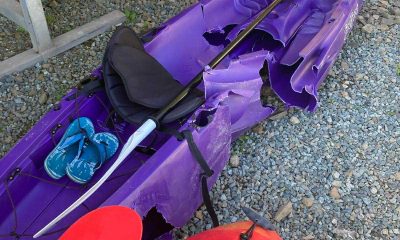
 Crime3 days ago
Crime3 days agoPembrokeshire haven master admits endangering life after speedboat collision
-

 Crime22 hours ago
Crime22 hours agoMother admits “terrible idea” to let new partner change her baby’s nappies alone







